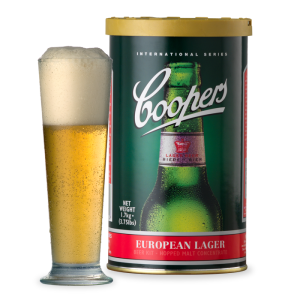The history behind Oktoberfest (known as Märzen when young), as detailed in the BJCP style guidelines, “…based on an adaptation of the Vienna style…Typically brewed in the spring, signalling the end of the traditional brewing season and stored in cold caves or cellars during the warm summer months. Served in autumn amidst traditional celebrations.”
It’s rare for a beer to go through a name change once it has aged in the bottle but they do present quite differently! Try making identical brews, 6 months apart, then perform a side-by-side tasting to compare a Märzen with an Oktoberfest.
Ingredients
1.7kg Coopers European Lager
500g Coopers Light Dry Malt
200g Crystal Malt (cararoma or munich malt)
Kit yeast (7g) plus Saflager W-34/70 yeast (11.5g)
STEP 1: Mix
Before mixing the brew, rehydrate the yeast by adding to 250ml of tepid water then stir to make a creamy mix and cover with cling-wrap.
Crack the specialty grains (put the grains in a plastic zip-lock sandwich bag and crack them with a rolling pin), add to 2 liters of water in a saucepan and bring to the boil then strain into the fermenting tub already containing the Light Dry Malt.
Pick the fermenting tub up and gently swirl the contents to dissolve the malt.
Add the contents of the European Lager beer kit and dissolve.
Add cold water up to the 20 liter mark and stir vigorously. Note: Fermentation should start at around the 22°C to 24°C so about 5 liters of refrigerated water may be required.
Stir in the creamed yeast mix.
STEP 2: Brew
Allow the brew to drop to 12°C to 15°C over the course of 12-24hrs then maintain this temperature during fermentation.
Cleanliness and Sanitation is even more important when making Lager beer, as the lower ferment temperature will extend the time the brew is in the fermenting vessel.
Fermentation may take 2 to 3 weeks.
STEP 3: Bottle
Bottle the brew with a priming rate of 8g per litre (2 carbonation drops per 750ml bottle).
Store the bottles out of direct sunlight at 18°C or above for at least 1 week while secondary fermentation occurs.
STEP 4: Enjoy !
Allow to condition for at least 4 weeks in the bottle before serving.
Download Oktoberfest Recipe PDF, Oktoberfest Recipe


MOST LARGER YEAST ferment about about 45 to 55 F after primary fermentation for a lager maybe 10 days rack into glass. the temperature of the wort should be brought to fermentation temp instead of after it starts fermenting to avoid esters which is an off flavor in a lager. allow to stay in the carboy until done fermenting then rack it off the sediment again, best to shoot co2 into the fermenter to protect the brew from oxygen, then rack the beer in and cool it to 32 to 40 F for lagering. it should larger 7 to 10 days for every 10 degrees of starting specific gravity. then bottle and aging is very important. the longer you can let it sit at cool temperatures the better the brew will be. of course most brewers do not have the supplies or patient for this step. all beers will improve with age. lagers are aged cold 32 to 40 F, for the time period stated. further aging will improve the beer. ales should be aged cold around 55 to 60 F for longer periods. the bigger the volume the slower the aging process. therefore kegs age slower. i like mine aged at least 1 year and better for 2. bottles should be aged for minimum of 6 months to a year. i realize no one is going to listen to me. bottles will start to oxidizes after 3 or 4 years i believe that is due to transfer of oxygen through the plastic in the cap. i have had perfect 10 or more years old kegs. of course i am very careful to remove as much oxygen from the keg.
ps, i believe the beer could use a little more sugar, i believe that the alcohol is a little low. i give my customers a rule to help them get into the right alcohol that they want in there beer. of course your hydrometer reading is the most important. starting gravity minus the ending. this little rule will get you pretty close. take the total pounds of sugar. malt whether dried or liquid malt, corn, and honey, and just subtract 2 it would give you alcohol by volume the same as your hydrometer at least pretty close. of course this depends on whether you want a slamming or sipping beer.